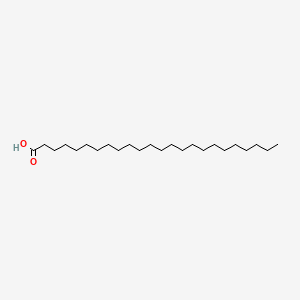| MeSH term | MeSH ID | Detail |
|---|---|---|
| Abetalipoproteinemia | D000012 | 7 associated lipids |
| Adrenoleukodystrophy | D000326 | 29 associated lipids |
| Diffuse Cerebral Sclerosis of Schilder | D002549 | 8 associated lipids |
| Chondrodysplasia Punctata | D002806 | 8 associated lipids |
| Diabetes Mellitus, Type 2 | D003924 | 87 associated lipids |
| Hyperthyroidism | D006980 | 12 associated lipids |
| Polycystic Kidney Diseases | D007690 | 12 associated lipids |
| Liver Neoplasms, Experimental | D008114 | 46 associated lipids |
| Metabolism, Inborn Errors | D008661 | 46 associated lipids |
| Refsum Disease | D012035 | 19 associated lipids |
| Sudden Infant Death | D013398 | 3 associated lipids |
| Zellweger Syndrome | D015211 | 39 associated lipids |
| Reperfusion Injury | D015427 | 65 associated lipids |
| Metabolic Syndrome | D024821 | 44 associated lipids |
Lignoceric acid
Lignoceric acid is a lipid of Fatty Acyls (FA) class. Lignoceric acid is associated with abnormalities such as Adrenoleukodystrophy and Peroxisomal Disorders. The involved functions are known as Anabolism, establishment and maintenance of localization, Saturated, Process and long-chain-fatty-acid-CoA ligase activity. Lignoceric acid often locates in Membrane, Microsomes, Plasma membrane, peroxisome and Mitochondria. The associated genes with Lignoceric acid are SLC27A1 gene, CD36 gene, F10 gene, INHA gene and ABCD1 gene. The related lipids are Sphingolipids, Fatty Acids, erucic acid, inositolphosphoceramides and Palmitates.
Cross Reference
Introduction
To understand associated biological information of Lignoceric acid, we collected biological information of abnormalities, associated pathways, cellular/molecular locations, biological functions, related genes/proteins, lipids and common seen animal/experimental models with organized paragraphs from literatures.
What diseases are associated with Lignoceric acid?
Lignoceric acid is suspected in Peroxisomal Disorders, Adrenoleukodystrophy and other diseases in descending order of the highest number of associated sentences.
Related references are mostly published in these journals:
| Disease | Cross reference | Weighted score | Related literature |
|---|
Possible diseases from mapped MeSH terms on references
We collected disease MeSH terms mapped to the references associated with Lignoceric acid
PubChem Associated disorders and diseases
What pathways are associated with Lignoceric acid
There are no associated biomedical information in the current reference collection.
PubChem Biomolecular Interactions and Pathways
Link to PubChem Biomolecular Interactions and PathwaysWhat cellular locations are associated with Lignoceric acid?
Visualization in cellular structure
Associated locations are in red color. Not associated locations are in black.
Related references are published most in these journals:
| Location | Cross reference | Weighted score | Related literatures |
|---|
What functions are associated with Lignoceric acid?
Related references are published most in these journals:
| Function | Cross reference | Weighted score | Related literatures |
|---|
What lipids are associated with Lignoceric acid?
Related references are published most in these journals:
| Lipid concept | Cross reference | Weighted score | Related literatures |
|---|
What genes are associated with Lignoceric acid?
Related references are published most in these journals:
| Gene | Cross reference | Weighted score | Related literatures |
|---|
What common seen animal models are associated with Lignoceric acid?
There are no associated biomedical information in the current reference collection.
NCBI Entrez Crosslinks
All references with Lignoceric acid
Download all related citations| Authors | Title | Published | Journal | PubMed Link |
|---|---|---|---|---|
| Costachel C et al. | Glycosylphosphatidylinositol-anchored fungal polysaccharide in Aspergillus fumigatus. | 2005 | J. Biol. Chem. | pmid:16204227 |
| Hagfors L et al. | Fat intake and composition of fatty acids in serum phospholipids in a randomized, controlled, Mediterranean dietary intervention study on patients with rheumatoid arthritis. | 2005 | Nutr Metab (Lond) | pmid:16216119 |
| Lücker E et al. | Transmissible spongiform encephalopathies: assessment of exposure risk in the histological working environment using GC-MS detection of fatty acids as marker for central nervous tissues. | 2005 | Int J Hyg Environ Health | pmid:16217923 |
| Oki S et al. | Preferential T(h)2 polarization by OCH is supported by incompetent NKT cell induction of CD40L and following production of inflammatory cytokines by bystander cells in vivo. | 2005 | Int. Immunol. | pmid:16291659 |
| Ndonye RM et al. | Synthesis and evaluation of sphinganine analogues of KRN7000 and OCH. | 2005 | J. Org. Chem. | pmid:16323834 |
| Okamoto H et al. | Transformation and characterization of mutant human fibroblasts defective in peroxisome assembly. | 1992 | Exp. Cell Res. | pmid:1639130 |
| Boles DJ and Rizzo WB | Dietary fatty acids temporarily alter liver very long-chain fatty acid composition in mice. | 1992 | J. Nutr. | pmid:1640260 |
| Yang LJ et al. | [Studies on the chemical constituents of Lagotis yunnanensis (II)]. | 2006 | Zhong Yao Cai | pmid:16617779 |
| Deon M et al. | The effect of Lorenzo's oil on oxidative stress in X-linked adrenoleukodystrophy. | 2006 | J. Neurol. Sci. | pmid:16750542 |
| Poerschmann J et al. | Sequential pressurized liquid extraction to determine brain-originating fatty acids in meat products as markers in bovine spongiform encephalopathy risk assessment studies. | 2006 | J Chromatogr A | pmid:16782118 |
